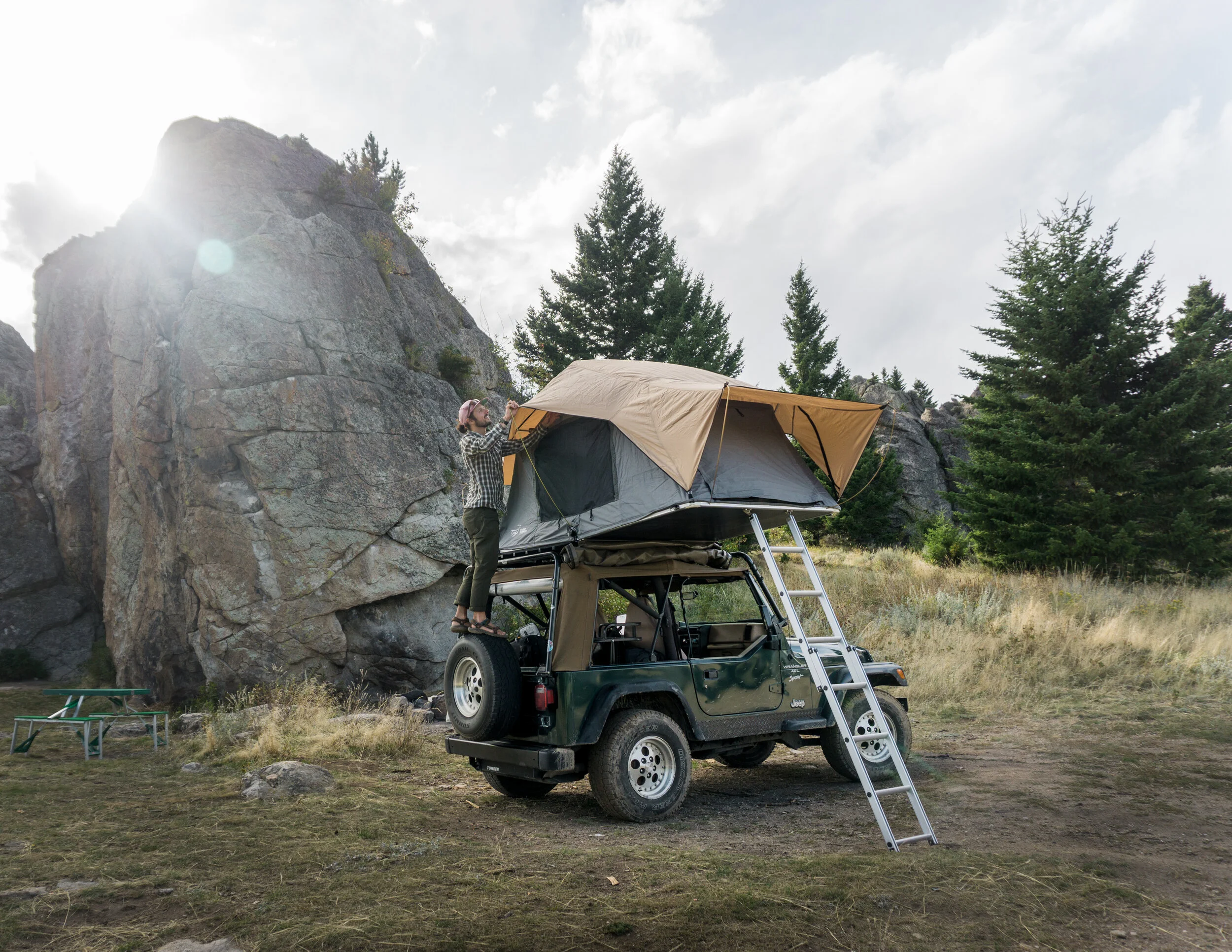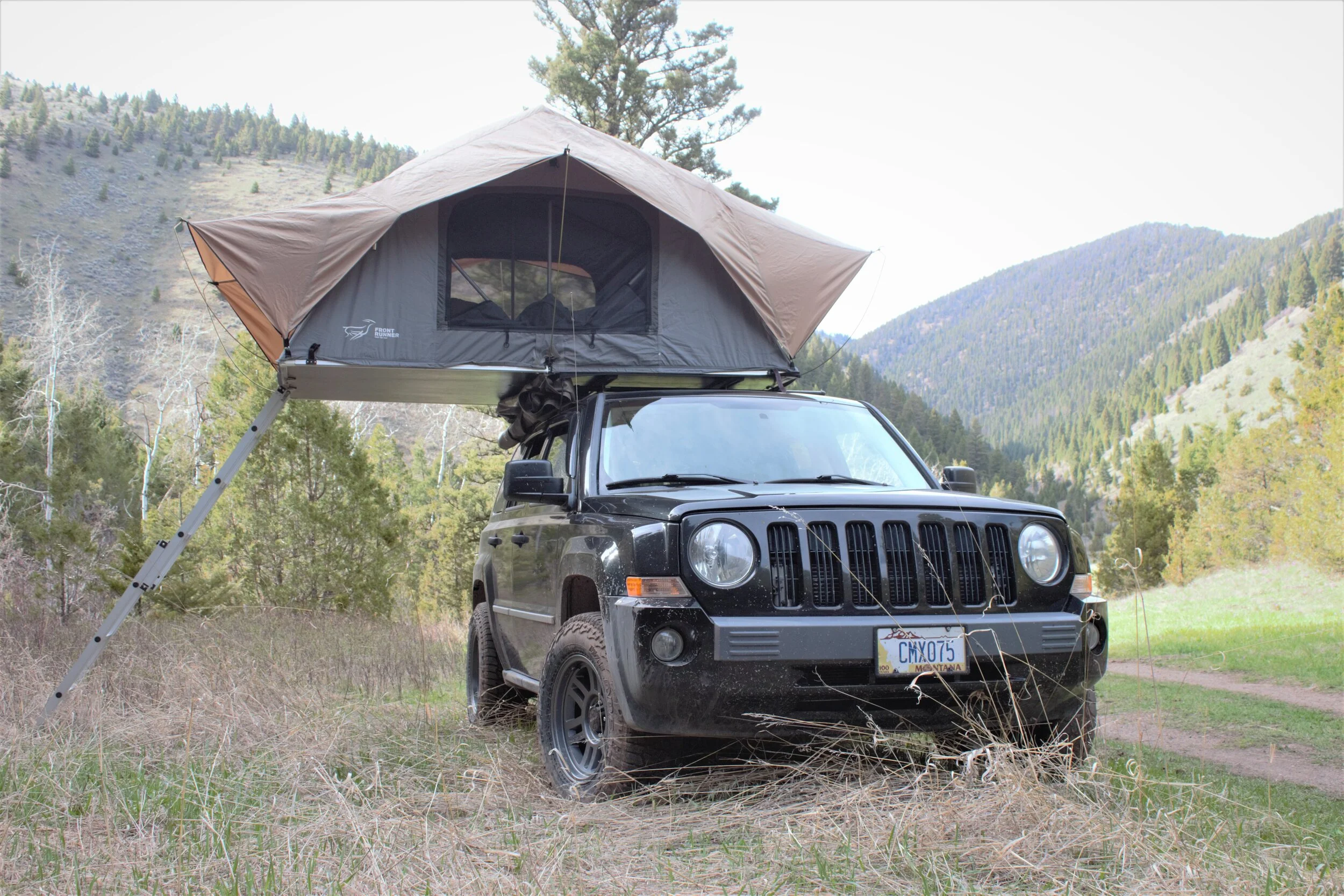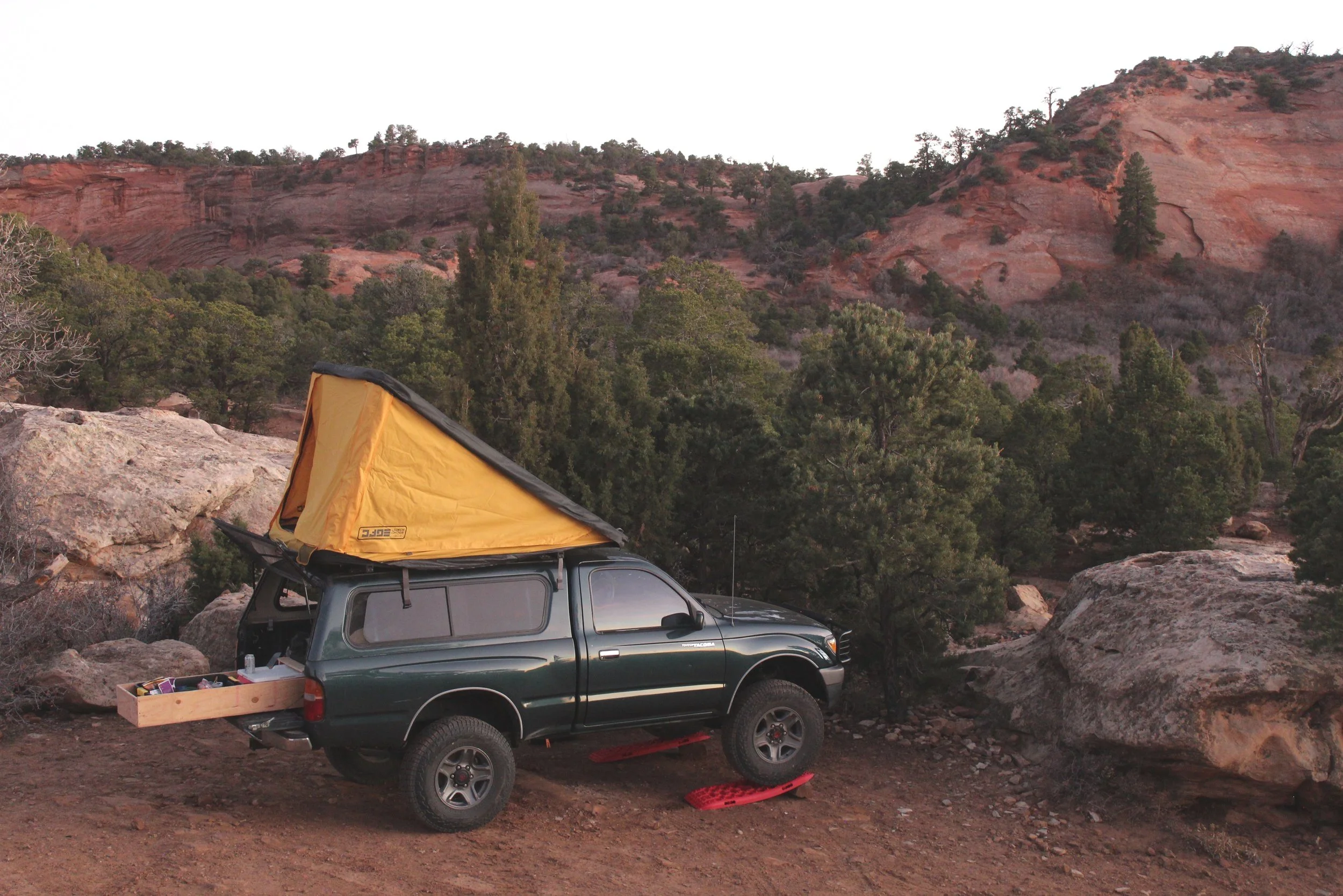4 Best Rooftop Tent Designs
Setting up a soft shell rooftop tent
So you want a rooftop tent and need help deciding between all the different styles? There is the soft shell, pop top, clamshell, wedge style the list goes on and on. Over the years I’ve had five different rooftop tents and have gone on trips with friends that have them too. By this time I know what I like and don’t like. I can’t tell you what is best for you and your purposes, but I hope to shed some light on the pros and cons of each style and what features to look out for. If you’d like to try before you buy be sure to head over to my main Montana Overlanding web page to find out how to rent one. Also, I will be frequently using RTT and an acronym for a rooftop tent.
Key Features
Before I dive into the different designs available I want to share some features I look out for in my rooftop tents. Some features are brand specific not design-specific. So once you know what design you want be sure to check the different companies' tent descriptions to make sure they also have the features that are most important to you.
Sleeping Bags
My top must-have in a rooftop tent is sleeping bag storage. Not all rooftop tents can hold your pillows and bags while it's closed. To me, this is a big reason to own a RTT. I’m all about efficiency. If I have to take the time to roll up a sleeping bag every morning I am not going to be a happy camper. And then my sleeping gear is taking up space inside my vehicle. There's also the chance of me dropping my pillow in the dirt whenever I take it out of the tent. Most companies have this feature now. But I will not buy a tent without it.
Setup Time
Different styles of RTTs have different setup and take-down speeds. This may or may not be your priority depending on how you travel. If you’re planning on using a RTT on a trailer to set up a basecamp then setup and take-down times probably aren't very important. But if you’re the kind of person that moves every day then that early morning takedown times can really add up. Though the speediest design might not be the roomiest. If you want a big king-sized bed and speed is less of an issue then there are options that have a happy balance (clamshell).
Weight
Even though we aren’t hauling our tents on our backpacks any more weight is still a big consideration. As a general rule before we start adding accessories to our vehicle we really need to know our rig's payload. If we have a vehicle with a 1000lbs payload, a four-person family that weighs 600lbs, their luggage 100lbs, coolers and cook wear 100lbs, well that doesn't leave much wiggle room for a 150lbs rooftop tent. These tents range from 85 lbs all the way up to 275 lbs. Usually, the heavy ones come with more features and comforts, but do we need those extra features? Most vehicles can't handle that kind of weight on their roof when traveling down the road. So a heavy-duty tent might need a heavy-duty roof rack, more weight, and more money. If you’re an avid offroader you may not like how your truck handles off-camber terrain with all the weight up top. But, if you are touring around the country with the family to see national parks then the altered handling may not matter. Also, ask yourself who is going to help you take this thing on and off, and how are you going to store it. Not all designs allow you to flip it on their side for storage.
4 Rooftop Tent Designs
1. Soft Shell
Softshell RTTs are a classic design. They are known as soft shells due to their waterproof fabric top covers. These tents fold out like a pop-up book to double their size compared to when they are stowed away. A pro of this design is the amount of room you get once deployed. It's like being in a big tree fort. Because they fold over the side of the car most can integrate a vestibule for extra ground shelter and shade. Softshell rooftop tents also tend to be on the more affordable side. Brand new these can run as low as $1200. Since they have been on the market for some time they are all over Craigslist and Facebook Marketplace. I’ve purchased a barely used one for $600 once! This makes the tent ideal for first-time shoppers looking to try them out. A downside of this design is the pack-up time. It can be a bit of a hassle to shove the extra material back under the cover after folding it back up. The zipper never seems to want to reconnect with itself and gets caught on the bulky tent fabric. Many require up to eight stakes to prop up the rainfly and windows which takes extra time as well. This can also be a pro too because this design allows for good ventilation even if it's raining outside. If it's nice weather I usually just prop the fly in front of the door, or just tuck it onto the roof. Because all sides of these tents are soft and they tend to make a lot of noise when the wind picks up. I usually keep a pair of earplugs packed for these nights. Other designs have hard sides that can be orientated into the wind to help with the noise. One last con is their on-road aero-dynamics. They stand up about a foot in the air once packed up, creating significant drag at highway speeds. The soft fabric shell also creates some wind noise.
Pros
Affordable
Big and roomy, with lots of head space
Integrates with ground shelter
Cons
Noisy in the wind
Setup and take down time
Not very aerodynamic
2. The Wedge
The Go Fast Camper Superlite on my personal truck in Moab
The wedge-style rooftop tent is fastly becoming the most popular design with good reason. The speed that it takes to pop these tents open is remarkable. Usually, it takes undoing two latches then a quick push on the roof, and boom you're set. Some companies advertise a 30-second setup time! Take-down time is often under two minutes. This is ideal when showing up late to camp or hitting the road in a hurry. Because of their shape, these tents can have great wind resistance if the front is put into the wind. Their design also keeps the fabric nice and tight keeping the flap down in crosswinds. Thou, this shape does not bode well for tall people who sleep on their backs. Because the front end tapers down one's feet can get crammed when pointed up to the roof. Unlike the softshell tent that doubles in size, the wedge has the same footprint when closed as when it's open. Making this tent the least roomy of all the designs. And because it only opens from one side you can only sit up by the backside. Which can be tough when both people are trying to change clothes at the same time, bumping elbows and such.
Now, the structure of the hard shell wedge tents is very rugged. Many have the option to put cross bars across the top. Depending on the load that you put on the roof you can still open it to sleep in without removing your stuff. Great for surfboards, skis, etc. Because this design is so simple companies are also making lightweight versions of this tent. Both the Go Fast Camper Superlite and Inspired Overland Tent claim to be under 90 lbs! This is a big deal for those in the offroad community and people with light crossover SUVs.
Pros
Fastest setup time
Flat aerodynamic on-road design
Low wind noise
Cons
Not the best for tall people
Less roomie than other designs
3. Vertical Poptop
Similar in design to the wedge tent with some obvious differences. These tents use latches on every side and when deployed they raise straight up. This gives it extra space compared to the wedge, with only a few seconds more setup time. Having both ends of the tent with identical heights allows you to sleep pointing in either direction. This can come in handy if parked on a slant and need to adjust your head uphill. It's also nice for spreading out a bit to play cards haha. This type of tent does not offer as much headroom as a soft shell, or as much as a wedge on the higher end. Most average-sized people will still be able to sit up inside the tent though. Because all sides of the tent are the vertical fabric it cant be oriented to block the wind. So, it can be noisy on windy nights. So far I have not seen any lightweight versions of this design.
Pros
Fast Setup
More foot room than the wedge
Cons
Less wind protection than other designs
May not be able to sit all the way up inside
4. Clam Shell/ Side Open Tents
The Tuff Stuff Alpha XL
The hardshell side opening tents are a fairly new design that has risen in popularity in the past five years. The first company to use this design is iKamper and others have followed suit. These tents are a great happy medium between setup speed and living space. They use the same latch system as a wedge/pop top but with one extra step of folding out the extra floor space as a soft shell tent does. These tents only take one minute more to set up/ take down compared to the wedge. They are far less stressful to pack away compared to the softshell. Because the hard shell top flips to the side we can still use this as a wind block. And because the floor flips over the side of the vehicle we can attach a floor shelter to the tent. These tents come in a large and small formats. The small version like Tuff Stuff Alpha II is nice because it doesn't take up the vehicle's entire roof platform. Great for if you like to store traction boards, pelican cases, or whatever on the roof. The large version however is the most spacious tent I have stayed in. The big downside to these tents is their weight. The large versions start at around 170 lbs. Not all vehicles can handle this kind of weight. This weight can definitely be felt when offroading or taking fast corners. If weight is of no concern I believe that this is a great design! The setup speed to comfort level is perfect.
Pros
Very roomy
Ease of setup
Cons
Weight
I hope that this helps in your purchasing process. And if you’d like to try before you buy be sure to check out my Montana Overlanding Booking page.
Cheers,
Aaron





